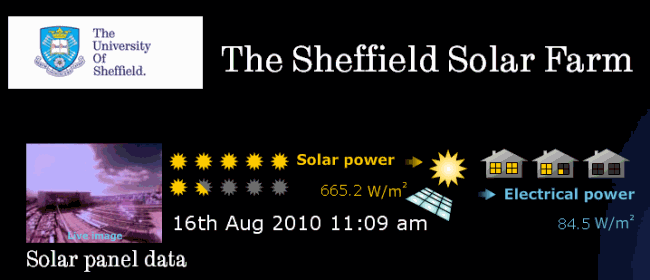Sheffield Solar Farm
The Sheffield Solar Farm aims to provide representative data about photovoltaic power output from test installations in the UK. It will help provide objective data on how efficient domestic Photovoltaic power might be in the UK, and so help to form policy, and provide a sensible body of knowledge for members of the general public interested in ‘doing their bit’ for the environment.

The website project is in three stages – to make public the results from the solar panels in real time, which we have now achieved. This is to be followed by displaying data from test installations using new photovoltaic materials, to allow comparison in real performance under a range of conditions. This is important because photovoltaic panels are rated at 1000 W/m2 solar power input – wheras the UK more commonly only manages a few hundred W/m2 sunlight. Unfortunately photovoltaic panel response is not linnear, so less sunlight input can mean a lot less electrical power output, as a consequence the array you’ve planned may not provide the power you are expecting! In the third stage people from around the UK will be invited to submit their own photovoltaic data, so providing a real measure of how panels perform ‘in the wild’ e.g. after being outside for a few years… This is the kind of data that many householders will need before making a commitment to the expense of an installation themeselves.
The site had a small graphic display showing what solar power is currently available, and what the electrical power output from the panels is on every page. The display is in Flash, but driven by an XML datafile generated on demand from the database. The alternative for people who do not have Flash is a static bar chart graphic that reflects the situation at the time the page was loaded.
In addition, there are graphs of solar power available and electrical power output, which currently display data for the last 24hrs. We evaluated two graphical packages for the project:
Flot is a nice Javascript based plotting system, that takes data in a list and spits out a pretty graph to order. It is not able to offer x and y axis labels, however…
jpGraph is a fully featured graphical package running in PHP. It takes a while to get it as pretty as Flot, but it is very flexible, and includes x and y axis labels. The ability to label axes neatly and correctly was a deciding factor in this instance, as the site is being developed by the Department of Physics and Astronomy, they wanted their graphs to be as clear as possible!
As general notes for the two packages, jpGraph places considerably more load on the server than Flot, as the graph is prepared as a graphic file for insertion into the page. This also means that the actual data is hidden from the visitor’s web-client.
The website is built in WordPress, where we adapted the latest Twenty_Ten templates to create our first production HTML5 website. We are still evaluating the new standard (which will not be fully released for many years – so we are not a long way behind the times!), and I think it fair to say that its reception is mixed. In many ways it is a regression, permitting the sloppy code that XHTML was intended to eradicate. At present the new graphical capabilities are not reliably realised in user’s browsers, however, so the trumpeted advantages of the new standard (which seem to centre around ‘Flash bashing’) are yet to emerge.
The Sheffield Solar Farm was visited by Nick Clegg, then Deputy Prime Minister, on the 20th August 2010.